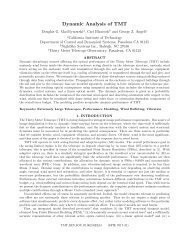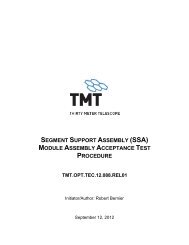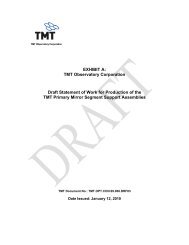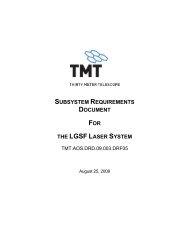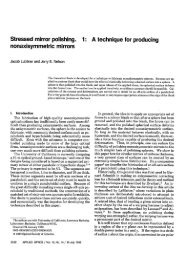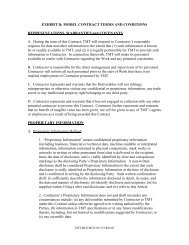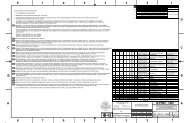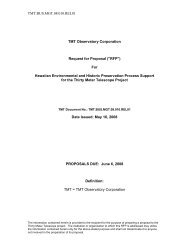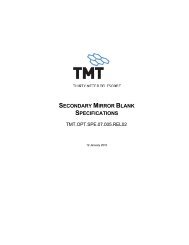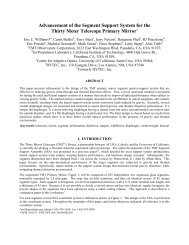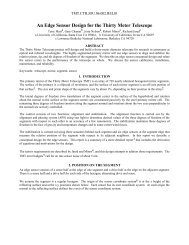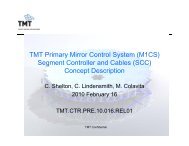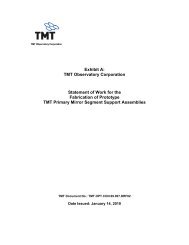TMT Construction Proposal - Thirty Meter Telescope
TMT Construction Proposal - Thirty Meter Telescope
TMT Construction Proposal - Thirty Meter Telescope
You also want an ePaper? Increase the reach of your titles
YUMPU automatically turns print PDFs into web optimized ePapers that Google loves.
Fig 3-1: Atmospheric transmission for a high altitude site (Mauna Kea).<br />
3.2 <strong>Telescope</strong><br />
The telescope itself is the key to achieving our science goals. In this section we will describe the performance<br />
desired for the broad science objectives of this facility. The telescope is foremost an optical system, but it must<br />
also move to point to science targets, and it must provide suitable support of the science instruments that<br />
attach to it.<br />
3.2.1 Optical<br />
The telescope optics limit observations in a variety of ways and we describe the desired performance for the<br />
major categories.<br />
3.2.1.1 Optical Configuration<br />
The circumscribing circle around the primary is 30.0 m, and the useful<br />
collecting area is about 655 m 2 . The primary mirror (M1) is the entrance pupil<br />
of the telescope.<br />
We want a closely filled aperture to produce diffraction-limited images with the<br />
strongest central concentration of the light. When the starlight is faint<br />
compared to the background, the noise under the star image dictates the<br />
sensitivity. The time needed to reach a given S/N is proportional to<br />
b*(equivalent-noise area) where b is the background/unit area and the<br />
equivalent-noise area is the area that multiplies the background b to yield the<br />
variance in the estimate of a star intensity [2]. This is directly proportional to<br />
the needed observing time. The equivalent-noise area is<br />
α = 1/ ∫PSF 2 dA, where the PSF is normalized so ∫PSFdA = 1<br />
where PSF is the point spread function. For a given collecting area but with<br />
different configurations, α is the reciprocal of the observing efficiency. We indicate α for diffraction-limited<br />
observations with two configurations: a filled circular aperture and the segmented, <strong>TMT</strong> primary mirror (as<br />
shown in Fig. 3-2).<br />
aperture<br />
Filled aperture 1.31e-4 arcsec 2 (1.00)<br />
<strong>TMT</strong> 1.36e-4 arcsec 2 (1.04)<br />
equivalent-noise area for 1 μm (relative integration time)<br />
Fig 3-2: Pattern of 492<br />
segments of the primary<br />
mirror.<br />
The <strong>TMT</strong> primary mirror configuration is shown in Figure 3-2. The diffraction pattern profile of this mirror is<br />
shown in Figure 3-3.<br />
Experience with large telescopes has shown us that a single mirror (M1) giving images at prime focus is limiting<br />
for science instruments. A two-mirror telescope (M1+M2) giving a final focus at the Cassegrain focus (typically<br />
behind the primary) is more useful. An even more useful system employs an additional third fold flat (M3) that<br />
allows the Cassegrain focus to be folded over to the Nasmyth platforms. This design lets the telescope<br />
accommodate multiple science instruments with more room.<br />
<strong>TMT</strong> <strong>Construction</strong> <strong>Proposal</strong> 20



